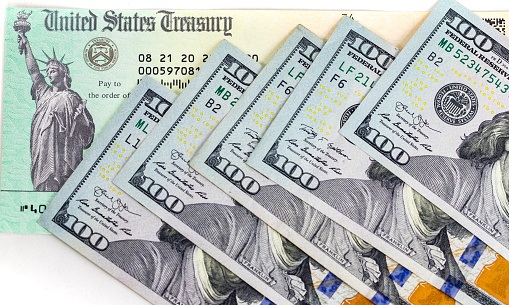Market Update
US government bond yields have seen considerable upside over the course of the last few hours, with the rally really kicking in when European participants arrived at their desks between 0600GMT-0700GMT. 10-year yields, which were trading closer to 1.65% overnight, have rocketed all the way to not far from 1.75%, a 9bps surge on the day. That has pushed the 2s10s spread (the difference between the US 10-year and 2-year yields – a proxy of yield curve steepness) to close to 160bps, its highest levels since 2015.
In terms of why bond yields are surging this morning, there is no specific fundamental catalyst or new piece of news driving the move. Rather, the move is likely being driven by shifting narratives around the outlook for the US economy, US inflation and Fed policy – the US economy is expected to see a roaring recovery over the next three years (a view with which the Fed agrees, just see their new super bullish economic forecasts) and inflation is expected to pick up strongly (how lasting the pickup in inflation is remains a key question). But despite the above, the Fed is signalling that it is going to stay super dovish… so it appears we face two scenarios; 1) economy running hot + very easy monetary policy = higher inflation = higher bond yields (via higher inflation expectations), the scenario the Fed seems to be signalling, or 2) economy running hot + higher inflation = Fed panicking and tightening monetary policy earlier than expected = higher bond yields (this time driven by a rise in real yields). Either way, the risks appear tilted towards higher bond yields, which could explain this morning’s move.
Surging US government bond yields are weighing on US equity markets in premarket trade – the S&P 500 and Dow had both hit all-time highs in wake of yesterday’s more dovish than expected FOMC event last night (the Fed’s new dot-plot had the median dot not showing any hikes through 2023, against some market expectations it would show hikes sooner), but these gains are now gone; S&P 500 futures nearly hit 3990 overnight, but have now slumped all the way back to below 3950, close to yesterday’s pre-FOMC levels. By comparison, European equities are holding up a little better; the rise in European government bond yields this morning has been milder and the ECB’s accelerated rate of purchases over the coming quarter is expected to keep them low anyway, so higher bond yield concerns are less of a worry for European bourses.
In terms of other asset classes, in FX, the dollar is nursing a recovery as US bond yields rise, with the DXY now trading at session highs in the 91.70s, up from overnight lows under 91.40, though there is still some way to go before the index reaches yesterday’s pre-FOMC levels of just under the 92.00 level. Turning to commodities; crude oil markets are a little lower, weighed by downside in US equities, amid a lack of any fresh crude specific fundamental catalysts since yesterday’s somewhat bearish EIA inventory report – one catalyst for crude oil could be the EMA’s verdict on the safety of the AstraZeneca vaccine, expected at around 1500GMT; if it deems the vaccine safe, as expected, then Germany, France, Italy, Spain and other European countries will restart their respective rollouts of the vaccine, which could boost crude oil market risk appetite. Finally, spot gold and silver are a little lower, both weighed by higher US yields (XAUUSD has dropped from overnight levels above $1750 to around the $1730).
Rest of the G10 FX
Aside from the USD, AUD is the best performing currency in the G10 this morning; AUDUSD surged above 0.7800 in wake of the Fed last night and then extended gains to as high as the 0.7850 level in wake of a very solid February labour market report, though the cross has since dropped back to the 0.7800 level. For reference, the Aussie economy added 88.7K jobs in February (more than the 30K expected), with the gain in employment made up entirely by full-time job gains (a sign of economic strength). Meanwhile, the unemployment rate dropped sharply back to 5.8% from 6.4% last month (a much steeper than expected drop to 6.3%), though this was in part driven by a drop in the participation rate to 66.1% from 66.2%.
GBP, CAD and JPY come a close third, fourth and fifth in this morning’s G10 rankings, each down about 0.2% on the session versus the buck. With regards to the former, we just had the release of the latest BoE monetary policy decision and updated economic forecasts; as expected, the bank rate was held at 0.1% and the bank’s QE envelope was maintained at a total of £895B. In its new monetary policy statement, the BoE maintained that the current policy stance is appropriate, noted that news of plans to reopen the economy are consistent with a slightly stronger economic outlook, but reiterated that it does not intend to tighten policy until there is clear evidence that significant progress is being made towards eliminating spare capacity and sustainably achieving its 2.0% inflation target. A lack of surprises from the BoE means that the reaction in GBP was very muted; GBPUSD continues to swing either side of the 1.3950 mark as has been the case throughout the European morning and overnight sessions, though the risk that it could drop to the south of this range is growing as US yields plough higher.
Turning to JPY; given USDJPY’s usual sensitively to movements in US government bond yields (which implies movement in US/Japanese rate differentials), the fact that USDJPY has not moved back up to above recent highs around 109.30 is somewhat surprising.
Finally, NZD and EUR are both lower versus the US dollar by about 0.4% and CHF is down by more than 0.5%; NZDUSD, which rallied north of 0.7260 overnight is now heading back towards the 0.7200, weighed by much worse than expected New Zealand Q4 GDP growth numbers released overnight. EURUSD is a victim of the recovering USD and is slipped back towards 1.1900 from overnight highs close to 1.1990, with comments from ECB President Lagarde having largely been ignored this morning (she reiterated the ECB will not allow European government bond yield increases to “get ahead” of the economic recovery).
Day Ahead
ECB Vice President Luis de Guindos is scheduled to speak at 1410GMT but has a history of not saying anything interesting/market moving, so EUR traders are unlikely to get too excited. ECB’s Schnabel often comes out with the more interesting commentary on the Eurozone economy and policy, so her remarks at 1800GMT are more likely worth watching.
Other events on the calendar today worth watching at 1) the EMA’s verdict on the safety of the AstraZeneca vaccine, expected at around 1500GMT and 2) a press conference with UK PM Boris Johnson at 1700GMT (speaking at the UK’s daily Covid-19 briefing).
The main driver of today’s markets is likely to be what happens with US government bond yields; following the already sharp rise, do they continue to go higher? If so, this could weigh on stocks and commodities and further lift the US dollar.




